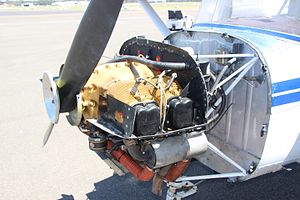
The Continental C90 and O-200 are a family of air-cooled, horizontally opposed, four-cylinder, direct-drive aircraft engines of 201 in³ (3.29 L) displacement, producing between 90 and 100 horsepower (67 and 75 kW).
Built by Continental Motors these engines are used in many light aircraft designs of the United States, including the early Piper PA-18 Super Cub,
Though the C90 was superseded by the O-200, and many of the designs utilizing the O-200 had gone out of production by 1980, with the 2004 publication of the United States Federal Aviation Administration light-sport aircraft regulations came a resurgence in demand for the O-200. The light-sport aircraft standard is for small, simple single- and two-seat aircraft for which the O-200 is well-suited.
The C90 was introduced in 1947 as a follow-on to the A65, which had been in production since 1939. The engine was developed from the earlier O-190 by increasing the stroke  1â„4 inch.
This engine family is considered to be dependable, according to both industry publications and the FAA.